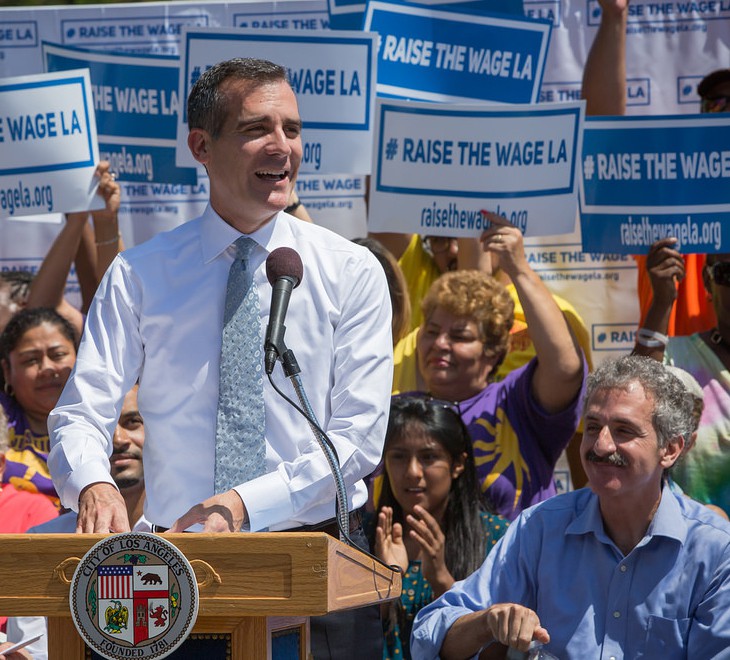The Existing Neighborhood
The Beverly-Virgil project area does not have a well-ordered pattern of land use or a clear economic trajectory that suggests an “obvious” economic development strategy. Many parts of the project area are physically inhospitable, with intense traffic, stark security fences, and a general lack of amenities. One of the challenges for redevelopment is to make the highly developed transportation infrastructure an asset that supports growth rather than a source of blight, and in particular to use the Vermont-Beverly subway station to leverage desirable development. The residential population within the project area appears to be too sparse to participate in neighborhood planning; another challenge for redevelopment is to create future possibilities for a more cohesive community.
Industry Structure
Because of the small number of businesses in the project area this report focuses on the project area together with a surrounding one-mile zone of influence. In this larger area:
- Twenty-four of the 25 industries that produce the most economic output and add the most value, and 90 percent of business start-ups, are in the service sector.
- Service industries are growing more rapidly than the City of Los Angeles as a whole, especially nonprofits, labor unions, advocacy organizations, health care, social assistance, and professional and technical services.
- There is little evidence of competitive strength in most non-service industries, including construction, manufacturing, utilities, transportation, and wholesale trade.
- Thirteen of the 25 largest industries paid average wages of over $2,500 a month in 2002 – a more desirable wage profile than is found in many other areas of LA.
- Ten hospital-linked industries can be identified that pay living wages and are potential candidates for growth.
Informal Economy
This is economic activity that is unreported to the state government, unregulated and untaxed. It is comprised of jobs that would otherwise be considered legal but are not effectively regulated in regards to the health and safety of workers, minimum wages, rights to organize and bargain collectively, prohibitions against discrimination, restrictions on child labor, documentation of immigration status, mandatory payroll benefits, and tax reporting. In short, they are hidden “under-the-table” and “off-the-books.” They can give rise to abuses by employers who fail to respect the basic rights of workers. Furthermore, they shortchange the social safety net, and create an unfair disadvantage for competing businesses that comply with the law. In the Beverly-Virgil study area:
- An estimated 41 percent of workers are employed in informal jobs. This is two and a half times greater than the rate of informal employment found in the City of LA.
- The public sector is shortchanged by $56 million annually in legally mandated social safety net costs that are not being paid for informal workers in the project area and surrounding one-mile zone of influence. In addition, roughly $10 million in sales taxes should be collected annually on purchases made by these workers.
Recommendations are provided for curtailing the informal economy through legal enforcement, technical assistance for employers, and labor market interventions.
Strategy Recommendations
Five strategies are recommended to improve prospects for economic growth:
- Facilitate affordable and market-rate housing to increase the housing stock.
- Make front-loaded investments to establish public open space, enhance pedestrian areas around the transit station and mitigate negative traffic impacts.
- Use the Vermont-Beverly station to leverage high-rise residential and mixed-use development.
- Engage industries with a functional interest in improving the project area as first movers and anchor tenants. These include:
- Public benefit organizations that are strongly represented in the area and functionally engaged in improving social and economic conditions.
- Green technology industries that have a direct interest in the environmental improvements put forth in the Station Neighborhood Area Plan and this strategy.
- Curtail rampant informal employment in the area that undermines wages, working conditions and public revenue.
A beginning list of 27 target industries is recommended based on projected future growth and payment of living wages.
Chapter Headings:
- Executive Summary
- Existing Study Area Development
- Physical characteristics
- Social capital
- Station Neighborhood Area Plan (SNAP)
- Development Scenario
- Size and diversity of Beverly-Virgil employer base
- Zone of Influence
- Key Findings
- Value of Industry Transactions and Business Survival
- Output and value added by industry
- Compensation to employees and owners
- Revenue required to create a job
- Survival of start-up businesses
- Size distribution of employers
- Key findings
- Industries and Employers
- Jobs
- Wages
- Industry overview
- Ranking industries
- Potential economic development linkages with hospitals
- Key findings
- Occupations Found in Key Industries
- Biggest occupations
- Essential skills
- Occupational wages
- Training time
- Key findings
- Informal Labor Force
- Overview of LA’s informal economy
- Estimated informal employment in the Greater Beverly-Virgil Area
- Jobs held by informal workers
- Cost of informal employment
- Key findings
- Parcel and Zoning Analysis
- Land use overview
- Zoning summary
- Tract analysis
- Key findings
- Economic Strategy Recommendations
- Strategy overview
- Target industries
- Hospital linkages
- Working tools













